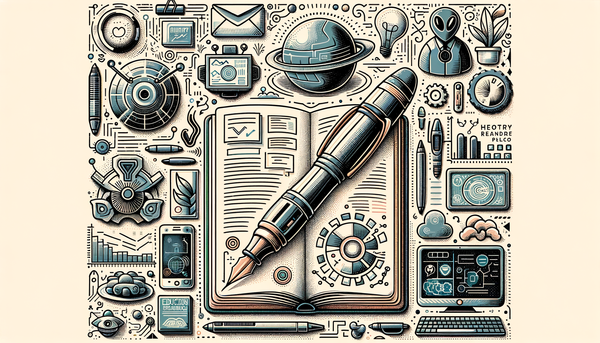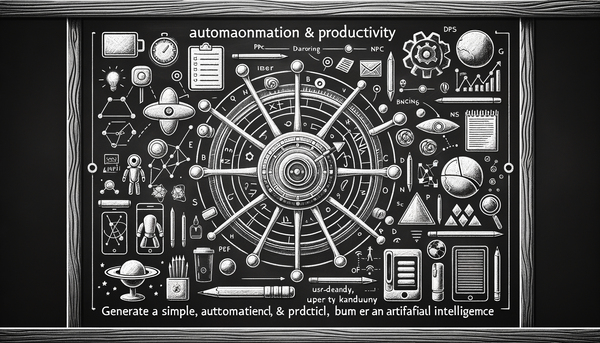My AI Agent: Revolutionizing Investing and Understanding Emotions

In this exploration of artificial intelligence, we journey through a spectrum of cutting‐edge applications—from the innovative use of Variational Autoencoders (VAEs) for creating synthetic data, to empowering everyday investors with AI-driven insights, to the novel role of AI in sports judging, and even to decoding the hidden emotional states of animals. We also examine strategic moves in the AI investment arena. This convergence of technology and creativity is reshaping industries, stirring debates, and inspiring fresh innovation.
The Art and Science of Synthetic Data with VAEs
Artificial intelligence has recently embraced Variational Autoencoders (VAEs) as one of its most promising innovations. The detailed tutorial from Towards Data Science has ignited interest among data enthusiasts and researchers alike. VAEs not only simplify the process of replicating realistic data but also provide a robust framework to mimic complexities found in real-world datasets—from image processing scenarios to intricate healthcare developments.
At its core, a VAE is a probabilistic graphical model that leverages deep learning's capabilities to learn latent variables representing input data. The benefit of employing such a model is its ability to generate new samples that share similarities with the original data, essentially simulating environments that are otherwise expensive or dangerous to recreate in the physical world. This is particularly relevant in medical research where synthetic datasets can be used to augment learning in patient treatment algorithms without compromising sensitive personal information.
For anyone intrigued by these techniques, there’s a treasure trove of wisdom from foundational math and probability theory blended with advanced neural networks. By bridging creativity with technical prowess, VAEs open new avenues for simulation and scenario testing, allowing innovators to experiment without the constraints of traditional data. It's an area where theory meets practice, redefining the boundaries of what can be achieved in synthetic data generation.
As one reflects on this breakthrough, I am reminded of the words,
"Real stupidity beats artificial intelligence every time." – Terry Pratchett
While we might chuckle at its irony, this quote underscores the importance of continuously challenging AI with creative problem-solving—even as we push the envelope in generating data that not only imitates but also innovates.
Democratizing Finance: AI’s Transformative Role in Investing
The intersection of artificial intelligence and investment is rewriting the playbook for financial management. The article at Forbes introduces us to the compelling narrative of "My AI Agent." Here, AI is not just a tool for the tech-savvy elite but a democratizing force capable of empowering ordinary individuals with insights typically reserved for seasoned professionals.
Gone are the days when market intuition and gut feelings dictated investment strategies. Modern AI systems, fueled by machine learning algorithms, can analyze astronomical volumes of data, identify subtle market trends, and provide personalized investment guidance in real time. By processing vast datasets from global markets, social sentiments, and even geopolitical developments, these AI agents have redefined the art of investment decision-making.
Such technological advancements resonate deeply with a broader business momentum. We have seen similar discussions on platforms like Pushing the Envelope of AI in the Intelligence Age, where technology is viewed as the ultimate equalizer in complex decision-making processes. With AI, even financial novices can step into markets with curated strategies, thus reducing undue risks while maximizing potential returns.
I often think about how transformative this is—when powerful technology starts working side by side with our everyday decisions. Interestingly, this transition mirrors historical revolutions where technology democratized access in various fields, whether it was the printing press or the Internet. We're witnessing a similar paradigm shift, ensuring that expert insights are no longer monopolies of the affluent.
Technology in the Ring: AI Judge Scorecards in Boxing
In an unexpected yet fascinating twist, AI is stepping into the realm of sports—specifically, boxing. The recent article in talkSPORT describes how an AI judge scorecard is set to play a critical role in the fight between heavyweight stars Dmitry Bivol and Artur Beterbiev. Boxers and fans are aware that judging in combat sports can be highly subjective; technology promises to bring objectivity to the ring.
The integration of an AI scorecard seeks to mitigate biases and provide consistent, data-driven assessments. By analyzing factors like punching accuracy, movement efficiency, and defensive tactics, AI can help arbitrate scores with precision previously unattainable by human judges. It is an ambitious leap, one that redefines fairness in sports judging—potentially informing standards across other sports.
This evolution in sports technology resonates with the broader narrative that AI is not confined to office spaces or laboratories. Much like the revolutionary ideas discussed in AI's Astonishing, Terrifying Evolution in 2023, the adaptation of AI in traditionally human realms, such as sports officiating, signals a future where technology augments human decision-making in real-time.
Reflecting on these developments, I recall Claude Shannon’s visionary thought,
"I visualize a time when we will be to robots what dogs are to humans, and I’m rooting for the machines." - Claude Shannon
The prospect of machines contributing to fair judging encapsulates that sentiment—trust in technology is slowly cementing its place in scenarios where precision is paramount.
Decoding Emotions Beyond Humans: AI and Animal Behavior
Artificial intelligence continues to push boundaries in unexpected fields. An especially heartwarming application is the use of AI to decipher animal emotions. An article published on The Brighter Side of News highlights a groundbreaking study where AI systems accurately interpret the emotional expressions of multiple animal species.
This technology works by analyzing vocalizations, body language, and distinct behavioral cues to assess emotions ranging from joy to distress. Imagine being able to understand your pet's mood simply by observing automated analysis—a tool that could revolutionize animal welfare and enhance communication between humans and their furry or feathered companions.
The implications of such technology extend beyond pet care. They have potential applications in wildlife conservation, veterinary sciences, and even in enhancing the quality of life for animals in shelters. In many ways, this innovation is harmoniously aligned with how human-centered AI is evolving; it is not merely about data, but about cultivating empathy and understanding in environments once considered too nuanced for algorithms.
As discussions around AI and empathy continue to surface in our community—echoed in articles like OpenAI's Emotional Exploration and the Future of AI Partnerships—the ability to decode and interpret emotions across species instills a sense of connectivity. It reminds us that technology can be a bridge, uniting disparate worlds under a common language of empathy and understanding.
Strategic Shifts in AI Investments: Nvidia and SoundHound
No discussion on the modern state of artificial intelligence would be complete without examining pivotal market moves. A recent Nasdaq article reported that Nvidia has sold its entire stake in SoundHound AI, a development that has sent ripples across AI investment circles.
SoundHound AI, once hailed for its advanced voice recognition and natural language processing technologies, now faces an uncertain future with Nvidia's exit. This move has sparked intense debates among investors, questioning whether it signals a drop in the company’s prospects or a strategic recalibration in an ever-evolving market. While some speculate that SoundHound will eventually find its footing again, others feel that the tech giant's move exemplifies the market's inherent volatility.
In the realm of business and technological investments, such decisions call for careful scrutiny and robust debate. Though we refrain from making any investment recommendations, the unfolding scenario offers a fascinating case study of market dynamics in the AI era. It reflects the delicate balance between technological potential and commercial viability, a recurring discussion topic similar to those explored in AI's Interesting Journey: From Emotional Intelligence to Custom Agents.
I find it intriguing how strategic financial moves like these underscore a broader transformation in the industry. While AI continues to serve as a powerful tool across sectors, investments in this field are often a reflection of optimism, caution, and sometimes, a recalibration of long-held beliefs about technological success.
Interweaving Narratives: AI's Cross-Disciplinary Impact
What unites these diverse stories is the thread of relentless innovation that defines artificial intelligence. From aiding researchers in generating synthetic datasets to reinventing financial advisory models, AI’s versatility is evident. Whether it’s ensuring fairness in the boxing ring or calming the fears of pet owners by interpreting animal emotions, AI is proving that its scope is boundless.
The convergence of these applications is a testament to our era’s rapid technological evolution. In a world where AI is often perceived in black and white terms, these multifaceted narratives reveal the complex interaction between technology, business, and society. One can draw parallels with historical revolutions of other industries; for instance, the way the Internet democratized information resonates with how AI is now democratizing both financial services and animal welfare.
This integrative approach is well captured in our own community narrative at AI.Biz, where various articles discuss how AI is continuously reshaping our everyday experiences. Whether you are reading about emotional exploration in collaborative AI projects or the relentless evolution described in pushing the envelope in the intelligence age, the picture remains consistent: AI is here to stay, and its impact will only deepen with time.
It’s a reminder of that often-quoted sentiment by A.R. Merrydew:
"Mastering the technology to create effigies of ourselves, will be our downfall." – A.R. Merrydew
While the tone might be cautionary, it also reflects the necessity of balance as we integrate these sophisticated tools into our lives. The art, then, lies in leveraging this potent technology in ways that amplify human creativity and ethical decision-making.
Looking Ahead: The Future Landscape of Artificial Intelligence
While the applications discussed here might seem disparate, they collectively hint at a future where artificial intelligence is as ubiquitous as the internet. As we stand on this frontier, the challenge is not simply about advancing technology—it’s about weaving these innovations into the fabric of society in a responsible, inclusive, and transformative manner.
The tutorial on VAEs not only demystifies a critical tool but also empowers a new generation of researchers to crack open doors to unexplored creative potential. In the financial realm, where AI is steadily leveling the playing field, even a small investor now has access to robust, predictive analytics. The integration of AI in sports officiating points to a future where human biases are minimized, and decisions are made based on data integrity. Meanwhile, decoding animal emotions transcends mere novelty—it holds the promise of fostering deeper empathy between humans and the natural world.
This tapestry of innovation is further enriched by real-world business moves, such as Nvidia’s strategic exit from SoundHound AI, urging investors and technologists alike to ponder the interplay of risk and reward in the fast-paced AI domain. Together, these narratives drive home the message that the AI revolution is not a distant dream but a present reality. As industries across the spectrum begin to harness AI’s potential, cross-disciplinary learnings will continue to fuel breakthroughs that once belonged solely to the realm of science fiction.
Our journey through these topics reveals that the evolving landscape of artificial intelligence is characterized by continuous adaptation and creative disruption. In the words of one visionary, “I visualize a time when we will be to robots what dogs are to humans, and I’m rooting for the machines,” a sentiment that encapsulates not just the technological potential but also our innate drive for progress and innovation.
The narrative is still in its early chapters, with every innovation leaving an indelible mark on the future. Whether you’re a researcher, a professional investor, a sports fan, or simply a curious observer, the unfolding story of AI promises to entertain, educate, and, most importantly, inspire.
Further Readings
- OpenAI's Emotional Exploration and the Future of AI Partnerships
- Pushing the Envelope of AI in the Intelligence Age
- AI's Astonishing, Terrifying Evolution in 2023
- AI's Interesting Journey: From Emotional Intelligence to Custom Agents
- The Next AI Revolution: A Tutorial Using VAEs to Generate High-Quality Synthetic Data
- My AI Agent: AI’s Role In Transforming Investing For Everyone
- AI Judge Scorecard Revealed for Dmitry Bivol vs Artur Beterbiev
- Groundbreaking AI Can Accurately Decode Emotions from Multiple Animal Species
- Nvidia Just Sold Its Entire Position in SoundHound AI. Should You Follow?



